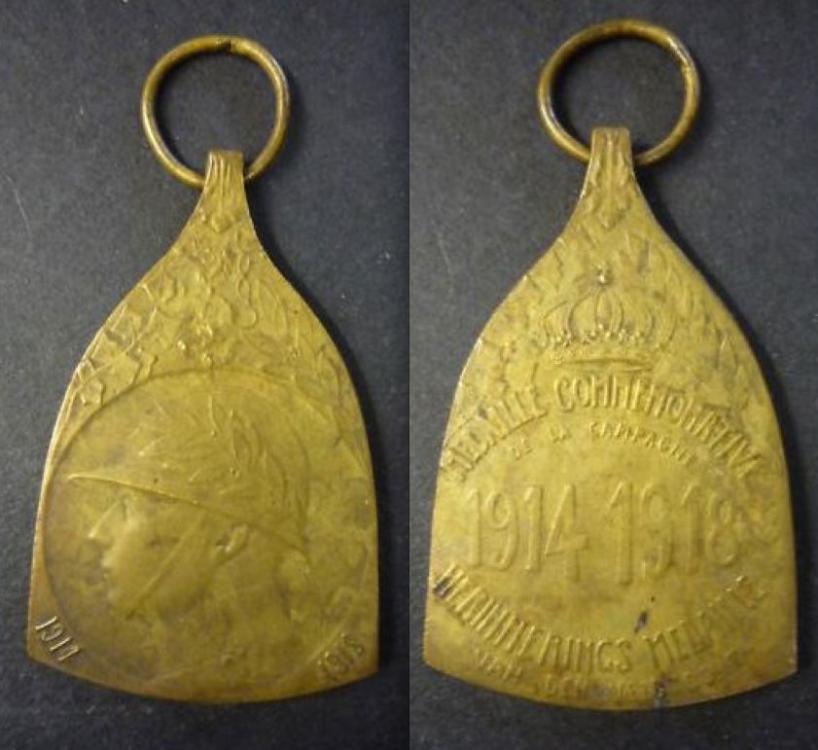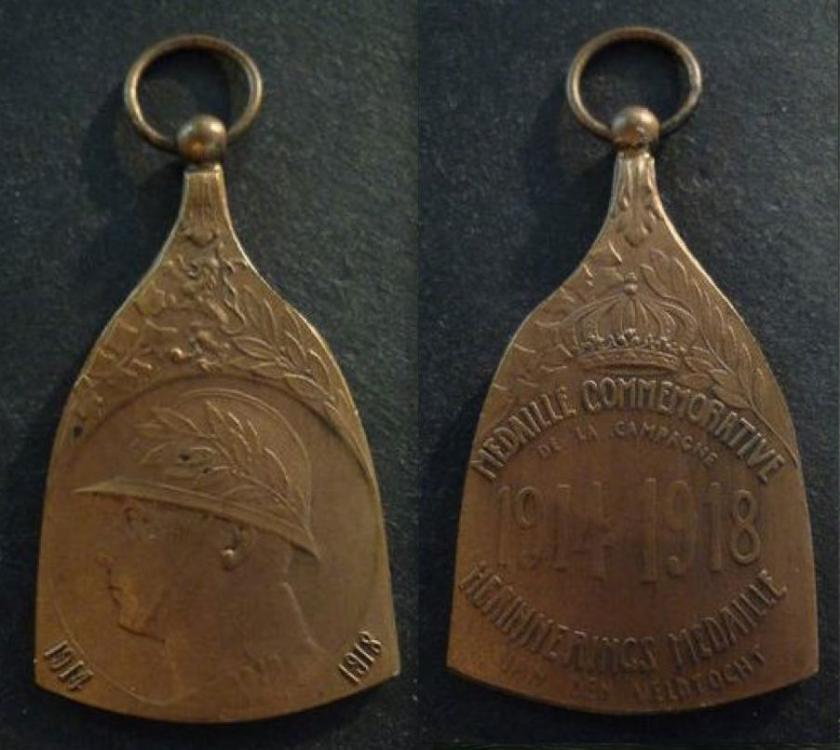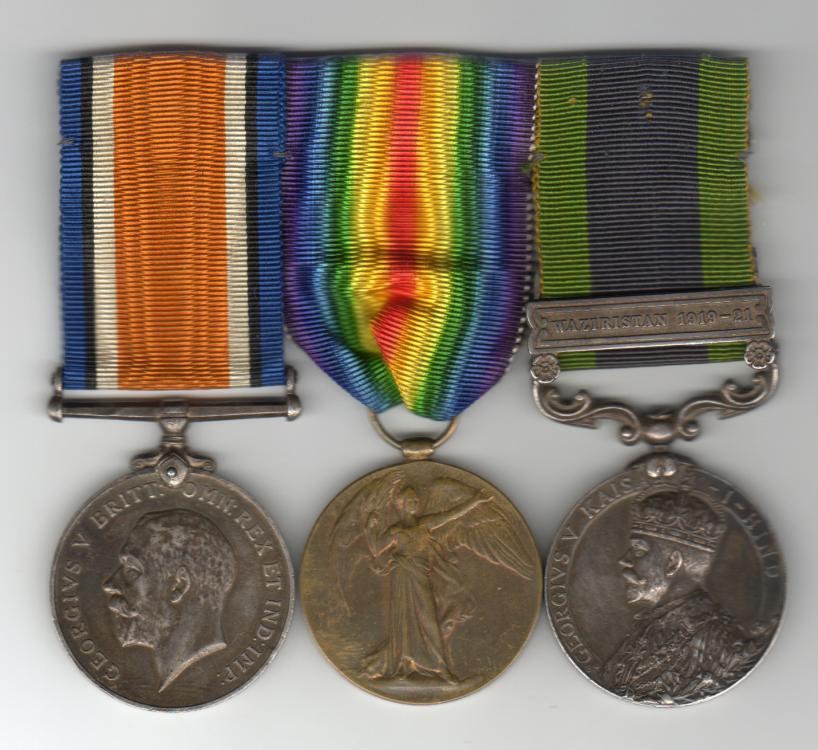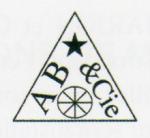-
Posts
1,169 -
Joined
-
Last visited
-
Days Won
1
Content Type
Profiles
Forums
Blogs
Gallery
Events
Store
Everything posted by RobW
-

Portuguese Victory Medals
RobW replied to Tim B's topic in Inter-Allied Victory Medals of the Great War
Hello Peron, As has already been indicated quite a nice pick up that you have. Finding any vic in good condition is always a challenge. Finding them in their original period boxes, that are also in good to moderate condition can be quite difficult. Some of the other medals produced by Frederico da Costa are also seen in red coloured boxes. Regards, Rob -
To all, The example in question, was produced by the Paris firm of M.Delande. They are generally of high production quality and are deemed to be 'unofficial' according to the authorative Laslo reference. Of note is that on the reverse of the suspension ring are the stamped words 'MADE IN FRANCE'. This at least dates the piece to having being produced circa 1931, as it was a requirement to have country of origin labeling to comply with US laws of the time. Regards, Rob
-
Welcome back Tim, Another collector of vics, in this forum, is a good thing. Regards, Rob
-

Belgium Belgium - Commemorative Medal of the War 1914-1918
RobW replied to a topic in Northern European & Baltic States
Hello Carey, As indicated here are two French made examples from the firm of M.Delande. They were obtained at the close-down of stock from that vendor. Both examples do not have the signature on the front nor the initials on the lower back. I hope that this was of use. Regards, Rob -

Belgium Belgium - Commemorative Medal of the War 1914-1918
RobW replied to a topic in Northern European & Baltic States
Hello Carey, I can't recall the exact differences at this moment. I will look into my picture files and I should be able to post some pics of the example mention for reference here. Regards, Rob -

Belgium Belgium - Commemorative Medal of the War 1914-1918
RobW replied to a topic in Northern European & Baltic States
Hello Hendrik and Carey, I have seen another very thick specimen of this medal. It was, however, of French manufacturer and was produced by the firm of M.Delande, so not necessarily relevant to this discussion. The giveaway in the French made example is that there were minor die variations. Regards, Rob -

American (US) Victory Medals
RobW replied to Kev in Deva's topic in Inter-Allied Victory Medals of the Great War
Hello Herman, A very nice example of a type 1. The difference in the planchet width is immediately obvious in the comparison shot. Regards, Rob -

American (US) Victory Medals
RobW replied to Kev in Deva's topic in Inter-Allied Victory Medals of the Great War
Hi Herman, You have picked up very nice example. The easiest way to check if it may be a wire loop variety is to look at the width of the planchet. In other examples seen the planchet is a bit thicker with thickness ranges between 2.7 - 3.0 mm. The medal planchet will also be of a much more copper-ish colour. Regards, Rob -

British Victory Medals
RobW replied to Kev in Deva's topic in Inter-Allied Victory Medals of the Great War
Hi Jerry, This group to a Naik of the 1-26 Punjabis Regiment shows a good level of toning and patina on the two silver medals. Complete groups to Indian recipients, with the silver medals, are becoming difficult to find. I always find those medals with a deep patina to be more interesting than those that have been polished. Regards, Rob -

Brazilian Victory Medals
RobW replied to RobW's topic in Inter-Allied Victory Medals of the Great War
Hello Lambert, It is good to see that you have finally managed to obtain such a rare piece. In regards the ring suspension it does look like it has been polished a bit or even maybe resoldered as it looks a different hue and patina to the rest of the medal. Either way a good pickup. Regards, Rob -

British Victory Medals
RobW replied to Kev in Deva's topic in Inter-Allied Victory Medals of the Great War
Hi Jerry, You have certainly picked up a nice pair. I wouldn't touch the BWM at all as the nice patina that has developed is as a result of the medal being silver. It is this patina which makes the item look particularly nice. Removing the patina by polishing would reduce the value of the medal and pair considerably. Regards, Rob -

British Victory Medals
RobW replied to Kev in Deva's topic in Inter-Allied Victory Medals of the Great War
Hi Bill, I have in my collection a late issue (never originally claimed) from February 1948, a reissue (medals returned due to naming error) from 1949, and a duplicate reissue (originals lost to Japanese during WW2) from 1950. In all these cases the medals were of a later striking that have minor production differences to the earlier 1920-1930's issues but were clearly from the same dies. I would probably characterise this example as a reissue. Given the MOD's response that they don't reissue the Great War medals unless they were returned, it is unlikely that they had any remaining stocks of the medals, or possibly even the dies, from the original 1920-1930's production timeframe. It would then make sense for the MOD to have to go to an 'approved' medal manufacturer to fulfill any such claims. In that regard these examples would be still be classed as reissues as the original had been returned. I would suggest that there would be very few of these 'reissues' given that passage of time. If they have come from the MOD then they are at least official in that sense. Regards, Rob -
Hi Bill, I have seen another example of a Belgian vic, in good condition, with no wear on the medal or ribbon, in another plain grey CH. Galère box. I have an undated catalogue of Establissment Charles Galère that shows the Belgian vic. In that regard it is likely that they produced the vic as it is listed for sale in their catalogue. Regards, Rob
-

Thai/Siamese Victory Medals
RobW replied to RobW's topic in Inter-Allied Victory Medals of the Great War
Hi Lambert, This is, indeed, a very nice example. Clean lines, with very little wear. A good example for those vic collectors with the money to fill the gap in their collection. It is suspended from the Great Britian variety of ribbon so that would need to be replaced with the French variety of ribbon to make it a bit more correct to type. Examples in this condition do not turn up that often. Regards, Rob -

American (US) Victory Medals
RobW replied to Kev in Deva's topic in Inter-Allied Victory Medals of the Great War
Hello Paul, Gaining the knowledge is a good thing as it provides context for what you are going to collect. As has been indicated by Lambert, be careful along the way, as there are many 'interesting' items that are not all they seem to be. Once you start down this road you will find there are many varieties to collect. Enjoy adding to your collection. Regards, Rob -
To all, It appears that the picture links didn't come through. I have attached a consolidated picture accordingly. This item is already listed on ebay so collectors could also find it there (auction no: 221698116084). Regards, Rob
-

American (US) Victory Medals
RobW replied to Kev in Deva's topic in Inter-Allied Victory Medals of the Great War
Hello Paul, Firstly, welcome to this forum. I am sure there will be much information here for you to draw on and like-minded collectors to converse with. As for your illustrated example; the medal and the bar looks good. The ribbon on the other hand has been taken from a more recent production, most likely one of the reissue varieties that were released in the 1980's onward. This has the characteristic 'crimp brooch' whereas the original ribbon had the wrap brooch. Not knowing the background to the medal I would not profer an opinion as to how and why the latter ribbon was used. Regards, Rob -

Italian Victory Medals
RobW replied to Kev in Deva's topic in Inter-Allied Victory Medals of the Great War
Bill, You have listed this italian vic as the reproduction type 4 in your book. Noting that your comments indicate it was sand casting and marked 'Made in France' could you provide details of the provenance and background of this example? Regards, Rob -

American (US) Victory Medals
RobW replied to Kev in Deva's topic in Inter-Allied Victory Medals of the Great War
Jim, It is this constant adding of smaller detail, in such a forum, that can expand already known information; or alternatively totally change someones previous interpretation of existing information. I am hopeful other vic collectors, other than the 'usual suspects', will continue to add to this information store here on the forum. Regards, Rob -

American (US) Victory Medals
RobW replied to Kev in Deva's topic in Inter-Allied Victory Medals of the Great War
Hello Bill and Jim, In answer to these two posts: I am not located with my collection at the moment. It is in long-term storage and will be so until at least the middle of next year. Consequently I will not be in a position to add any further pictures of makers marks on the edges of my French produced US vics at this time. As far as the different varieties is concerned I don't have much to add to the comments already posted by me (#26) although since that time I have obtained another French produced US vic that has no markings on the edge at all. It is slightly smaller in diameter than that usually seen and has the characteristic fine details of a French manufactured medal. It is most similar to Bill's most recently posted example but has minor die differences. It is, again, with my collection in long-term storage. I am hopeful that other collectors will also present pics of French made vics in their collections. Regards, Rob -

American (US) Victory Medals
RobW replied to Kev in Deva's topic in Inter-Allied Victory Medals of the Great War
Bill, Here is an illustration of one of the Arthus-Bertrand marks. Source: 'La Médaille coloniale, Guide du collectionneur', Patrick Binet, PBCO Editions, 2010 Regards, Rob -

Portuguese Victory Medals
RobW replied to Tim B's topic in Inter-Allied Victory Medals of the Great War
Hi Peron, The similarities between this statue and the obverse of the Portuguese vic, are obvious. Thanks for posting this picture. Regards, Rob -

American (US) Victory Medals
RobW replied to Kev in Deva's topic in Inter-Allied Victory Medals of the Great War
Hi Bill, This example was not produced by the French firm of Delande. It was, however, produced by the French firm of Arthus-Bertrand. The triangle shaped makers mark, which you have highlighted, belongs to the firm of Arthus-Bertrand. The letters 'AB' can be clearly seen on the left edge (as viewed) of the mark. It is a nice example which, with some gentle cleaning and soaking of the verdigris, should come up nicely. The good condition French manufactured ribbon is a bonus as well. Regards, Rob -

British Victory Medals
RobW replied to Kev in Deva's topic in Inter-Allied Victory Medals of the Great War
Hello Jerry, My apologies for mis-identifying you as Jenny. Fat fingers on the keyboard! Regards, Rob -

British Victory Medals
RobW replied to Kev in Deva's topic in Inter-Allied Victory Medals of the Great War
Hello Jenny, Welcome aboard. I am sure that you will find a range of information on the vic series to satisfy you. Regards, Rob






